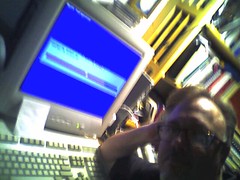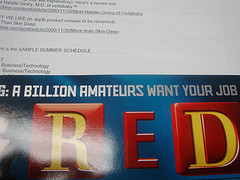Long Day
It’s going to be a long day. I never sleep well before a conference, especially one where I feel, going in, a bit out of my element. It will be a literacy conference, where their speakers in the past have been reading specialists. My task will be to convince the educators that reading, in a networked, digital, and overwhelming information environment has gotten a whole lot bigger, and a whole lot more exciting.
So I’m up very early this morning, going through e-mail, checking my aggregator, fixing a problem on my web site, and trying to condense all the thoughts that were banging around in my head, at 3:00 AM, into a single blog entry.
I guess what woke me was a bit of bitterness that I’m feeling, during those moments when I take time to find something to be bitter about. I know that last year’s NECC was fabulous, in a fabulous city, with lots of new stuff going on. Our only complaint, leaving the conference, was the lack of WiFi access in the presentation rooms — and the folks at NECC had their ears on the blogosphere. It looks like we will have WiFi this year. (Look for more in 2¢ Worth about that in the near future.)
This year, I’ve already got a gripe. I’m sure there was no way around it, given the calendar, but this year workshops will be held in conjunction with the general conference, and I’m teaching an all day workshop on Thursday. ..and guess what! The keynote speaker on Thursday morning is Nicolas Negroponte.
Being a history teacher at heart, I am fascinated by the personalities that have fueled the unprecedented technological advancements of my adulthood, and one of the brightest personalities has been Negroponte. Born in Greece, his area of study was architecture. But his entry into the world of technology was about the architecture of how we interact with our machines. Out of this passion came the MIT Media Lab, a place, time, and event where people are “inventing the future,” as Stewart Brand put it in his 1987 book, The Media Lab.
I’ve visited the Media Lab on three occasions, and my impression is that they’ve built a play ground, invited a bunch of really smart people to come, and said, “play!” Out of this play ground came much of how we operate our computers, what we look at on them, and much more in what we see and hear about the world around us.
What amazes and intrigues me about Negroponte is that he successfully directed a lab where scientists were empowered to play at observing, tinkering, and inventing, and at the same time convinced corporate America to invest in the value of playful invention. What an incredible story-teller he must be. It’s the kind of story-telling we need to turn our classrooms into a place of playful learning and to convince the public that these are the classrooms that our children and our future need and deserve.
I’m not too bitter about missing the address. He’ll be talking about the $100 laptop (a major Negroponte initiative), and won’t be sharing much that I don’t already know and nothing that I don’t already believe. Still, I’d love to see him.
I’m actually, much more excited about the next time I’ll see Chris Lehmann, who recently had a conversation with the Media Lab director. That’s a conversation I’d love to dissect.
Off, now, across two time zones today, adding two hours to my day. Can you spell strainonthebrain?

 With these words, General John A. Logan, of the Grand Army of the Republic, proclaimed the first Decoration Day, later to become Memorial Day, a day on which we, in the U.S. honor those who have died in battle. The official national holiday was proclaimed in 1971 by President Richard Nixon, in the National Holiday Act of 1971 (Public Law 93-363), which established a number Mondays as national holidays, creating for three-day weekends. My son will be home from school, today, though my daughter works for six hours at her summer job.
With these words, General John A. Logan, of the Grand Army of the Republic, proclaimed the first Decoration Day, later to become Memorial Day, a day on which we, in the U.S. honor those who have died in battle. The official national holiday was proclaimed in 1971 by President Richard Nixon, in the National Holiday Act of 1971 (Public Law 93-363), which established a number Mondays as national holidays, creating for three-day weekends. My son will be home from school, today, though my daughter works for six hours at her summer job. 


 On my media page, I have aggregated the latest photo posted on flickr and tagged with Web2.0, and this morning I was treated to an interesting piece by
On my media page, I have aggregated the latest photo posted on flickr and tagged with Web2.0, and this morning I was treated to an interesting piece by  The windows of the 21st century classroom let in more than light and they are no longer a distraction. We can now make our classrooms transparent, bring the world that our children are learning about into their classrooms, help them to learn by dialoging with their world, give each child a lens on which they can telescope and microscope their past, present, future, their place and time, their culture, and society. Within the context of a world-connected education, students will learn what humans do, they will learn to think and they will learn to communicate. No need for curriculum. Just guides and the tools to help them examine and interact with their world.
The windows of the 21st century classroom let in more than light and they are no longer a distraction. We can now make our classrooms transparent, bring the world that our children are learning about into their classrooms, help them to learn by dialoging with their world, give each child a lens on which they can telescope and microscope their past, present, future, their place and time, their culture, and society. Within the context of a world-connected education, students will learn what humans do, they will learn to think and they will learn to communicate. No need for curriculum. Just guides and the tools to help them examine and interact with their world.